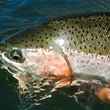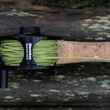I’m interested not only in fish, but in food, and I’ll sometimes find myself reading a book about some aspect of food history, the development of American cuisine, or something of that sort. Right now, I’m reading Lost Feast, by Lenora Newman. Subtitled “Culinary extinction and the future of food,” Lost Feast chronicles once-abundant foods that have been lost, beginning with Pleistocene megafauna such as the mammoth and the aurochs (the latter the imposing, wild ancestor of our domestic cow), through the more modern extinction of the passenger pigeon, which was once shipped in barrels to provide cheap nutrition to the new hordes of factory workers in industrializing urban centers, to the varieties of fruits and vegetables that have been sacrificed to the needs of mechanized agriculture.
Some such losses, like that of the mammoth and aurochs, took place over millennia. Some, like the extinction of the passenger pigeon, took place over centuries, while others, such as the loss of more than half of the named cultivars of the tomato, took decades and are still going on.
As I read the book, I began to think of the fish that are gone from my table, that disappeared in the course of my lifetime. Newman spent some time discussing issues with seafood, but in a book, no matter how well written, such discussions can feel too abstract to take personally. When I think of the fish that have become lost to me, even if some remain scattered thinly somewhere in the ocean, the ghost of their taste and texture still haunts my tongue. I can think of the times when I caught them, and the friends and family who were once able to share the fishing and the food, but never will again.
Fall is a good time for such thoughts, because the lost fish all favored cool weather.
Winter Flounder
Winter flounder was probably foremost among them. Anyone who knows me knows that I’m somewhat obsessed with the flounder. I fished for them since I was very small. They were the thread that connected family weekends throughout my boyhood, something I fished for with friends a bit later on, and the first fish that my new wife and I fished for after we were married. In the spring, we ate freshly caught flounder accompanied by the first asparagus spears from our garden. In the fall, after we moved to Long Island, we took our then-young niece and nephew flounder fishing in the waters of Great South Bay. There was nothing quite so good as a breaded flounder fillet, turned golden brown from its time in the pan, from a fish just a few hours out of the water. Moist, white flesh sheathed in crisp breading, the season’s last vegetables from the garden, potatoes, maybe a glass of local Chardonnay.

As I’ve written so often before, the flounder began to decline sometime in the 1980s, neither the state, nor the Atlantic States Marine Fisheries Commission, nor the New England Fishery Management Council, which managed them while out in the ocean, were willing to impose the sort of tough management measures needed to stem the decline, and by the first years of this new century, they were more or less gone.
Today, the Southern New England/Mid-Atlantic stock of winter flounder is considered to be overfished, with spawning stock biomass languishing at less than one-third of the target level. Low recruitment, coupled with the pressures created by a warming ocean, make rebuilding the stock a difficult, and perhaps an impossible, task. Although a very few still swim in Long Island waters, I doubt that I will ever feast on winter flounder again.
Rainbow Smelt
Yet, as scarce as winter flounder may be, they seem abundant compared to the rainbow smelt that used to make their way into Connecticut estuaries and bays as October began to wane. I wrote about smelt in the very first edition of my blog, One Angler’s Voyage, back on January 5, 2014. It was a good way to start, as smelt, of all the fish that played a significant role in my life, were the first to disappear.
The recreational smelt fishery that existed in the western end of Long Island Sound back in the 1960s is a difficult thing to describe to someone who wasn’t there. Smelt are small fish; I would guess that the typical smelt that we caught might have been six or so inches long. But while they were small, there were a lot of them; on a very good night, a fortunate angler could put close to a hundred fish in his pail. Of course, there were other nights when the fish were few and far between, but that didn’t make too much difference, because it was the fishing, more than the fish, that mattered.
The smelt bit best after dark, although some were caught in the daytime, too. But their nocturnal propensities meant that anglers didn’t have to wait for the weekend to catch them. They could just wander down to the town dock (where fishing was technically illegal, but back then, no one cared) after work or after dinner, and toss in a line. It became a sort of social phenomenon. Every evening, from mid-October until the creeks froze over (and even after that, for folks willing to dip the bars of their chainsaws into freezing salt water), the docks were lined with anglers fishing for smelt. Bright white points of light from the burning mantles of dozens of Coleman lanterns pierced the night.
Everyone on the dock was male, and more than a few kept themselves warm on cold autumn nights with frequent nips from a bottle of booze. The fishermen formed a rough, profane, yet welcoming fraternity of men that was very attractive to someone poised on the cusp of adolescence, eager to trade the company of boys for that of grown men. My father was one of the “regulars,” who knew everyone else on the dock, and on school nights firmly denied my entreaties to tag along when he headed out to the water after dinner.
But I still hung around the fringes, fishing for smelt by myself on weekend afternoons, and once in a while joining my father for an evening trip on a Friday or Saturday night. At the end of such trips, when things worked out well, I’d come home with a few dozen small fish that were gutted, battered, and tossed in hot fat, until the skin fried crisp and the white flesh beneath was flaky and sort of dry. To be honest, smelt weren’t my favorite fish to eat, but their symbolic value as a creature that, in its capture, opened the door to adulthood, gave them a flavor that mere flesh never could.
Smelt are anadromous fish, and need to be able to run up rivers to spawn. They are also a cold-water species, with Long Island Sound close to the southern extent of their range. Dams that blocked access to spawning grounds, coastal development that degraded spawning habitat, and declining water quality, perhaps coupled with the impacts of climate change, began to whittle away at smelt abundance. I last caught them in the fall of 1968, and haven’t heard of anyone catching them from my old home waters since. Published research found that, by 2006, smelt no longer spawned in Connecticut waters. A very unique fishery, and a very different food fish, had completely disappeared. And the smelt was not alone in its decline.
Atlantic Tomcod
When we fished off the docks in the fall, Atlantic tomcod often joined the smelt in our pails, just as they often joined the flounder that we caught in the spring. Usually, we caught them in modest numbers, but every once in a while, when we hit things just right, we caught tomcod in numbers that far exceeded the smelt or flounder that we caught. I still remember one afternoon when, fishing in front of the sewer pipe outfall at a park up in Greenwich, I hooked tomcod as quickly as I could get new baits in the water, and kept on doing it until all my pails overflowed.
As their name suggests, tomcod are a member of the Gadidae, the same family of fish that includes such species as haddock and Atlantic cod. Thus, it should hardly be a surprise that they made very good eating; when I was a boy, they were my mother’s favorite fish. Breaded and fried, the fine-grained, sweet meat had no better anywhere in Long Island Sound.
Both tomcod and smelt like cold water. Both are anadromous. Like smelt, tomcod prefer to spawn in fresh water if they can reach it, but they are also able to spawn in the brackish reaches of rivers if that’s the only water available. Thus, tomcod and smelt are impacted by the same negative environmental conditions, although tomcod’s willingness to spawn in brackish water may make it somewhat more adaptable. So it shouldn’t be surprising that, when the smelt population crashed, tomcod crashed, too, although they didn’t crash quite as hard, and a very few can still be found in southern New England salt creeks. Even so, they are no longer a viable target for anglers seeking a meal.
Atlantic Cod
And just about the same thing can be said for some of the tomcod’s larger and more ocean-going relatives, most particularly the Atlantic cod. Yes, cod remain a commercially and recreationally viable species at some places and times, but that’s not saying much. Right now, the Gulf of Maine stock is badly overfished, with spawning stock biomass somewhere between 6 and 9 percent of its target, and it continues to experience overfishing. With respect to the other, Georges Bank stock, a 2020 operational stock assessment advised “the Georges Bank Atlantic cod (Gadus morhua) stock status cannot be quantitatively determined due to a lack of biological reference points associated with the PlanBsmooth [population modeling] approach but it is recommended to be overfished due poor stock condition, while recommended overfishing status is unknown.”
What that means as a practical matter is that, unless you’re dining or buying your fish from a portside operation that purchases direct from the boat, or perhaps from a very high-end outlet that is willing to pay top price for scarce seafood, the cod that you’re eating here in the northeast was probably caught off Alaska or Iceland, and not from the grounds off New England which once provided cod to much of the Western world.
If you want to catch your own cod, be prepared for cold weather, short seasons, small fish, and a substantial probability of failure. The days when we could fish in our shirtsleeves off southern New England and regularly put double-digit cod on the dock are gone, probably forever. The steaks, fillets, cod cakes and chowder that we once enjoyed have disappeared, too.
Whiting
The same could be said for another once-iconic winter fishery for silver hake—more popularly called “whiting”—that occurred through the early 1980s in the New York Bight. It was primarily a party boat fishery, with most boats making multiple trips, day and night, bringing their fares back to the dock with burlap bags filled with whiting. A New York Times fishing report from April 1977—when the whiting fishery was already slowing down for the season—noted that “Capt. Ronald Santee of the Fisherman, which operates out of Atlantic Highlands [New Jersey], reported that whiting and ling (a/k/a red hake} were present at Ambrose Tower and Scotland Light, with catches running 30 to 100 fish a person.” Even on a sparsely-populated party boat with just 30 people on board, that would amount to somewhere between 900 and 3000 fish per trip on a typical day.
Today, the National Marine Fisheries Service reports that, for all of 2019, not a single whiting was caught all year in the state of New Jersey. During the COVID-impacted year of 2020, that figure supposedly jumped all the way from zero to 7. Clearly, for the New York Bight angler, whiting represent yet another lost seafood feast, although those willing to buy them can still find fish caught far offshore.
The Next to Go
Thinking about the smelt, the tomcod, and flounder, thinking about whiting and cod, inevitably leads one to think about what’s coming next. How many more lost seafood feasts are waiting to happen along our local shores? The current news isn’t particularly encouraging.
While scup and black sea bass remain at high levels of abundance, and the summer flounder population, although well below its target level, is not overfished, other inshore species in the northeast are not faring well.
Unless you live in Rhode Island or Massachusetts, your tautog (blackfish) stock is either overfished or still rebuilding, and the Atlantic States Marine Fisheries Commission decided to let the Long Island Sound stock endure overfishing until 2029; who knows how many will remain by then. Bluefish are overfished, although NMFS recently approved a seven-year rebuilding plan. Striped bass and weakfish are also overfished, but the ASMFC has yet to put a rebuilding plan in place for either one.
So the question needs to be asked: Which one will constitute the next lost seafood feast? Right now, my money is probably on tautog, with striped bass a strong second place. Although the answer still can be none of the above, if folks can shake off their lethargy and insist that managers take action to conserve and rebuild dwindling stocks while there is still something left to preserve.































Comments
Jerry Kustich replied on Permalink
Excellent article...but so depressing. I appreciate Charlie's historical perspective from a guy who has been at it for decades and able to truthfully assess the situation accurately. Fisheries everywhere are on the brink...not sure there is any hope in an age when fact denial has become an epidemic.
Rip Woodin replied on Permalink
The loss of fish is happening everywhere and essentially for the same reason—state managers will not make the hard decisions needed to rebuild stocks. Here in North Carolina, the Southern flounder harvest has been cut 72 percent after stock collapse was imminent. Weakfish and striped bass have all but disappeared. After trying for 30 years to work with the N.C. Marine Fisheries Commission, the N.C. Legislature and the Governor's office, CCA NC filed suit last year charging the state has abrogated its fiduciary duty to protect marine resources for all to enjoy, both now and in the future. CCA NC has won the first two key rulings. Please visit ccanc.org to learn more. This is the only hope to rebuild fish stocks for recreational and commercial fishermen.
Jerry Kustich replied on Permalink
Thanks for the comment and the work you have put into the situation. The good ole times are gone, and it's time to address fishery issues unique to the 21st century before the fish populations are beyond repair. It will take an all hands on deck approach, and the "good ole boy" attitudes need to be replaced with sound management tactics.
Paul replied on Permalink
We use to net smelt here in the Great Lakes too. They are now unavailable except to the fishing trawlers. Nothing better than a fresh smelt fry. They are mostly gone now thanks to man's foolishness about how eco-systems work. The ignorance and willful misconduct will be the end to us all... oh and the inflated ego!
Pages